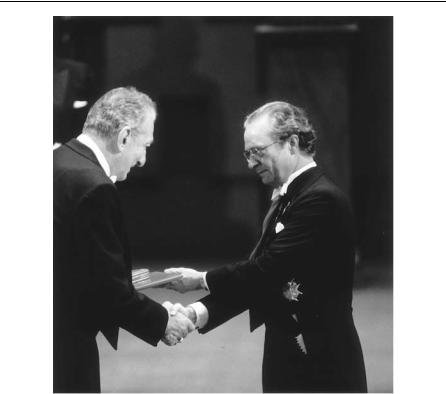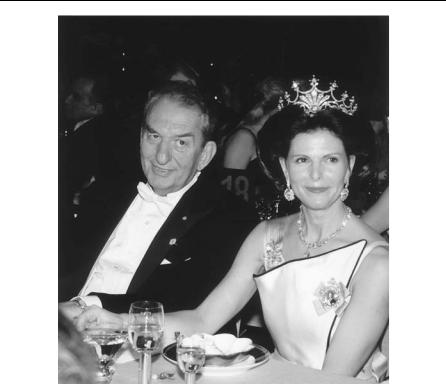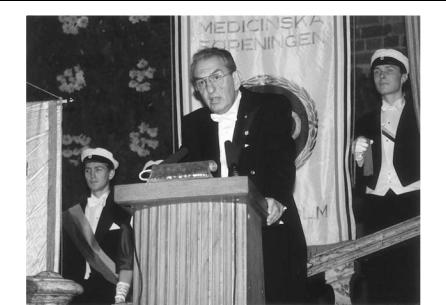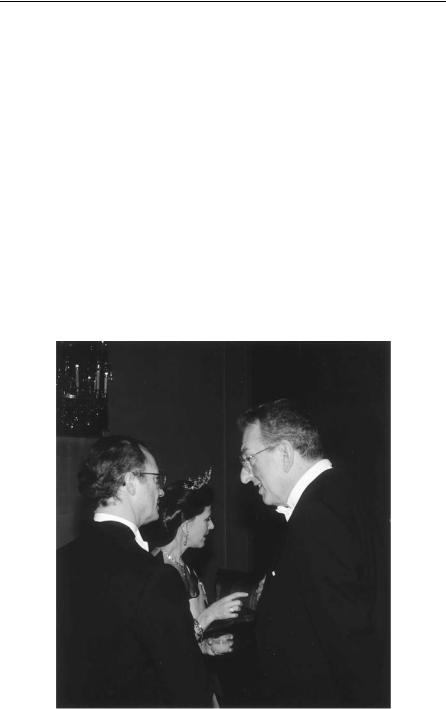
Olah G.A. - A Life of Magic Chemistry (2001)(en)
.pdf
180 A L I F E O F M A G I C C H E M I S T R Y
Receiving the Nobel Prize from King Carl Gustav XVI, December 10, 1994
members of the Government and Parliament, diplomats, and some 1200 invited guests. Attendance at the banquet, we were told, is the most sought-after social invitation in Sweden.
We were first taken to a suite for cocktails and to organize for the entry into the banquet hall. The procession formed and then began. It was led by King Carl Gustaf XVI with Judy on his arm. This all followed protocol, according to which the King accompanies the wife of the physics winner, if there is a sole winner, or if this is not the case that of the chemistry winner, etc. Because the physics prize was shared that year, but I was the sole chemistry winner, Judy found herself leading the procession on the arm of the King. They were followed by the Queen, escorted by the President of the Nobel Foundation. The procession started on the mezzanine floor, which ran the length of the hall, and we marched down the impressive marble stairs into the large

T H E N O B E L P R I Z E 181
ground floor hall and then split to either side of a very long table. It was a most thrilling entrance, with trumpets blaring and everyone standing and cheering.
At the dinner, too, Judy was seated next to the King, and I was across the table at the side of the Queen. Queen Silvia is a beautiful and gracious lady. During the dinner I learned she was born in Heidelberg, Germany; her mother was from Brazil, where she spent part of her youth. We talked about many topics, not the least our children and her many duties, including the annual Nobel events, with which by now she was very familiar. The guests were seated at tables perpendicular to the main one, with our family and guests sharing a table with our Swedish chemist colleagues.
The banquet began with the Chairman of the Foundation proposing a toast to the King, who then answered with a silent toast to the memory of the great benefactor and philanthropist Alfred Nobel.
The banquet itself was a superbly choreographed event. Each course was brought in by hundreds of waiters descending the same staircase with musical and lighting accompaniment like a well-orchestrated ballet. The tables were beautifully set with gold-plated china and crystal specially designed and used only for the Nobel banquet and decorated with a profusion of flowers. These, I learned, were flown in from San Remo in Italy, where Alfred Nobel had a winter home (and where he died).
Toward the end of the dinner laureates representing each prize were called upon for a brief (not more than 3 minutes) remark. I generally don’t write down any of my remarks or speeches, but this was a special occasion and I was requested to provide a text. Thus I can reprint here what I said:
Your Majesties, Your Royal Highnesses, Ladies, and Gentlemen, I am most grateful for the honor bestowed on me today. Although receiving the Nobel Prize is the greatest satisfaction any scientist can experience, I consider it not only a personal acknowledgment, but also that of all my students, associates and colleagues whose dedicated work over the years allowed my field of chemistry, which is not frequently highlighted in public, to be recognized.

182 A L I F E O F M A G I C C H E M I S T R Y
With Queen Silvia at the banquet dinner
There are many facets of chemistry. Mankind’s drive to uncover the secrets of live processes and use of this knowledge led to spectacular advances in the biological and health sciences. Chemistry richly contributes to this by helping our understanding at the molecular level. Chemistry is, however, and always will be a central science of its own.
Chemists make compounds and strive to understand their reactions. My own interest lies in the chemistry of the compounds of the elements carbon and hydrogen, called hydrocarbons. These make up petroleum oil and natural gas and thus are in many ways essential for everyday life. They generate energy and heat our houses, fuel our cars and airplanes and are raw materials for most manmade materials ranging from plastics to pharmaceuticals. Many of the chemical reactions essential to hydrocarbons are catalyzed by acids and proceed through positive ion intermediates, called carbocations.

T H E N O B E L P R I Z E 183
Remarks at the Nobel dinner
To be able to prepare and study these elusive species in stable form, acids billions of times stronger than concentrated sulfuric acid were needed (so called superacids). Some substituted carbocations, however, are remarkably stable and are even present in nature. You may be surprised to learn that the fine red wine we drank tonight contained carbocations which are responsible for the red color of this natural 12% or so alcoholic solution. I hope you enjoyed it as much as I did.
Chemistry does not always enjoy the best of reputations. Many of our plants and refineries are still potentially dangerous and may pollute their surroundings. At the same time our society enjoys a high standard of living not in small measure through the results of chemistry, which few would give up. I believe that chemistry can and will be able to bring about an equilibrium between mankind’s needs and our environmental concerns. Chemistry will continue to benefit mankind in the spirit of Alfred Nobel, a fellow chemist whose example continues to inspire us all.
The audience particularly liked the red wine part. So did I, because usually it is not easy to explain what my ‘‘carbocations’’ are all about.

184 A L I F E O F M A G I C C H E M I S T R Y
At the end of the banquet, we ascended the stairs to the Gold Room, where there was dancing till the early hours of the next day. Judy and I were, however, too exhausted after the long day, and after some private time with our Royal hosts we returned (or shall I say floated back) to our hotel.
The next day, Sunday the 11th, the Royal couple gave a dinner in their palace for the laureates and some 200 guests as a conclusion of the Nobel week. The austere, impressive palace I was told by the Queen is not suited to bringing up a family and they use it only for formal entertainment.
There was one other event for us to remember. While December 10 is Nobel day in Sweden, December 13 is St. Lucia’s day. We were awakened early morning by a knock on our door and were greeted by a singing group of white-clad girls carrying candles and a traditional
With the King and Queen of Sweden after the Nobel banquet

T H E N O B E L P R I Z E 185
breakfast to honor Santa Lucia. It was a moving and memorable morning.
During the week in Stockholm I also visited the University of Stockholm and the Royal Technological Institute. Subsequently, I also visited and lectured at Uppsala University and the Universities of Gothenburg and Lund. We were received everywhere with great friendship and hospitality, ending our most memorable trip in Copenhagen, from where we flew home. It was time to come back down to earth from the skies and resume our life.
The Nobel Prizes also come with a monetary award, which that year amounted to close to a million dollars. Besides paying taxes on it (the U.S. is the only country that taxes the Nobel Prizes), we donated part of it to help endow a chair in chemistry at USC as well as a chemistry prize in Hungary. The balance was shared with our children. It was thus not difficult to dispose of the prize money, but money, of course, is really not the essential part of the Nobel.
Concerning taxes, I was told that even the Nobel gold medal could be taxed based on its weight (seemingly the only value tax authorities put on it). I must confess, however, not to have paid duty on it, even after declaring it properly upon our return home. The nice lady customs inspector inquired as to how I acquired a gold medal. My wife told her that it was the Nobel medal I had just received in Stockholm. To my surprise, she not only knew what this was but shook my hand, saying that I was the second Nobel laureate she had had the pleasure to meet personally (the other was Linus Pauling). She decided that my ‘‘acquisition’’ of the medal did not come under the duty rules. I hope neither of us will get into any trouble for it.
Winning the Nobel Prize inevitably brings with it, besides a brief period of wider publicity (which in America evaporates particularly fast), a steady stream of invitations, varied honors and recognitions, as well as more general public involvement. Professors and scientists in American life are usually not exactly at the top of the ‘‘social ladder,’’ nor are they used to much recognition. Personally, I rather like this, because it helps not to attach overgrown significance to one’s importance, keeps one humanized, and, most important, allows one to stay centered without much distraction from one’s work. It was, therefore,

186 A L I F E O F M A G I C C H E M I S T R Y
certainly an initial shock that for a while the limelight of the Prize seemed to intrude on my well-organized, quiet life. However, friends who have gone through this before assured me that this would soon slow down and that if you are set to continue your life in your ‘‘own way’’ it is possible to manage it. They were indeed right.
Being fairly strong willed, I was determined to continue my life with as few distractions as possible. Thus I was back at my university duties the day after our return from Stockholm. Research and teaching were always an integral part of my life, not just a ‘‘work habit,’’ and I could not see any reason for change. I also did not feel ready for retirement, formal or de facto, while pretending otherwise. I like teaching and still feel able to contribute significantly to research. In short, I felt disinclined to rest on past laurels.
I must confess that it was easier to set my goals than to carry them out. All of us have only a finite amount of energy and available time. Furthermore, one of the most important aspects of my life always was to keep a balance between my professional and personal lives. Even so, I am afraid I had frequently shortchanged my family, particularly my children. Under no circumstances was I prepared to do this again, even more so as our adorable grandchildren, Peter and Kaitlyn, added new vistas and pleasures to our family life. On the other hand, I believe it is essential to stay active, and outside chemistry I do not know many ways to achieve this. However, I did make adjustments. I decided not to take on new graduate students, as the long-range major commitment needed to properly guide them through 4 or 5 years of research seemed unrealistic. I continued, however, to work closely with graduate students already in my group, helping and counseling students of the Loker Institute and working with my postdoctoral fellows, who increasingly became the mainstay of my research group. My close cooperation with my colleague and friend Surya Prakash also continued unabated in areas of mutual interest. He built up over the years an impressive research program on his own, while in areas of hydrocarbon chemistry and some other fields of mutual interest our joint research continues. I also extended my research into some exciting new areas (see Chapter 13).
One of the essentials of living with the Nobel Prize was to learn to firmly say no. Of the large number of invitations I receive for various

T H E N O B E L P R I Z E 187
events, recognitions, and lectures. I only accept a few. In any case, many of these are frequently not so much for me personally as for the lure of having a Nobel Prize winner for the event. Once you realize this, it is easier to decline. For a long time, I practically never traveled without Judy and do so even less now. We also travel less, although generally once a year we still go to Europe, never, however, if we can help it, in the winter. For us there is no place to live like Southern California. We swim each morning year round in our pool, to keep in shape and for our health, but also because we enjoy it so much. Where else could you do this, and afterwards go to your laboratory? We also decided to travel first class on long trips to lessen the stress associated with travel. A friend, Harry Gray, told us some time ago to do this, because if you do not, your children will. We agree and hope that our children understand.
As long as the enjoyment of teaching occasional courses, even to freshmen, doing research, and working with my younger associates and colleagues lasts and I feel able to make meaningful contributions, I intend to continue and not to rest on any past achievements. I believe this also keeps me active and interested past an age when others would have decided long ago to quit. Otherwise, continuing what I enjoy doing comes naturally, and I still have creative ideas and follow them up. One day when this is no longer the case, I fully intend to retire and start to act my age. While writing this I just learned that I am to receive the Arthur C. Cope Award of the American Chemical Society, which emphasizes achievements the significance of which became apparent in the past five years. This gives me particular pleasure because it acknowledges primarily my work done after my Nobel Prize. In any case, I try to follow the advice of a friend, Jay Kochi, who sent me a quotation from Edward Lavin’s Life Meditations: ‘‘There are two things to aim at in life: the first, to get what you want, and after that, to enjoy it. Only the wisest of mankind achieve the second.’’ I am not very wise, but I try to follow this advice.
12
Post-Nobel Years:
From Superacids to Superelectrophiles
The Nobel Prize frequently puts so many new responsibilities and preoccupations on the shoulders of the winners that it drastically changes their lives and affects their ability (or desire) to continue active research. I have heard some express the opinion that having received their prize at a more advanced age was in a sense a blessing, because it did not hinder their work throughout most of their career. This indeed may be the case, although Alfred Nobel’s intention was to encourage and facilitate research through his prizes. However, as I mentioned in Chapter 11, I was, determined that the Prize should not affect my life, and certainly not my research, significantly. Now, six years later, and looking back on these post-Nobel years, I feel that I mostly succeeded. These were productive and in many ways most rewarding years of research. Helped by my dedicated younger colleagues and associates and by close collaboration with my colleague Surya Prakash, who increasingly took over many of the responsibilities and burdens associated with running our institute, I was able not only to continue my research but to extend it into new and challenging areas.
A significant part of my previous research was based on the study of carbocationic systems using superacids and their chemistry. The acids I was able to use and explore turned out to be many billions or even trillions of times stronger than previously recognized ‘‘strong’’ acids such as concentrated sulfuric acid. Acids are, in a general way, electron acceptors. Concerning protic (Brønsted) acids, in the condensed state there is no such thing as the unencumbered, naked proton (H ). Having no electron, H will always attach itself to any potential
188

P O S T N O B E L Y E A R S 189
electron donors (whether n- [nonbonded], -, or even -electron donors such as H2). In the case of Lewis acids (such as AlCl3, BF3), their electron deficiency is affected by the stabilizing effect of ligands (neighboring groups) attached to the electron-deficient central atoms.
There are basically two approaches to enhancing the acidity of protic acids in the condensed state. The first involves decreasing the encumbrance of the proton by decreasing the nucleophilicity of the system. In aqueous media the proton is attached to water, forming the hydronium ion, H3O (in its hydrated forms). In anhydrous HF it is H2F , in fluorosulfuric acid, FSO3H2 , and so forth. The leveling effect means that no system can exceed the acidity of its conjugate acid. Thus no aqueous acid system can have acidity exceeding that of the conjugate acid of water, H3O . Because the proton transfer ability of H2F is higher than that of H3O or FSO3H2 , acid systems based on HF are stronger acids than those based on oxygenated acids.
The second approach is the use of increasingly lower-nucleophilicity anions and dispersion of the negative charge of the counter-anions (in the condensed state cations always must be balanced by anions). When anions are associated as, for example, via fluorine bridging going from SbF6 to Sb2F11 , Sb3F16 , etc., charge is increasingly dispersed. In Al2C7 etc. chlorine bridging also occurs but is generally less predominant in bringing about higher association than fluorine bridging.
The vastly increased acidity of superacidic systems resulted in the significant new field of superacid chemistry. I began to ask myself whether a similar but more general approach could be used to produce electrophiles of greatly enhanced electron deficiency and thus reactivity. Over the years, there were a number of unexpected results in my own research work, as well as some previously unexplained observations buried in the literature, that seemed worth pursuing.
Because of the mentioned leveling effect of the solvent (or excess acid itself acting as such) the acidity cannot exceed that of its conjugate acid. In the case of water the limiting acidity is that of H3O . Protonated water, H3O (hydronium ion), was first postulated in 1907, and its preeminent role in acid-catalyzed reactions in aqueous media was first realized in the acid-base theory of Brønsted and Lowry. Direct experimental evidence for the hydronium ion in solution and in the
